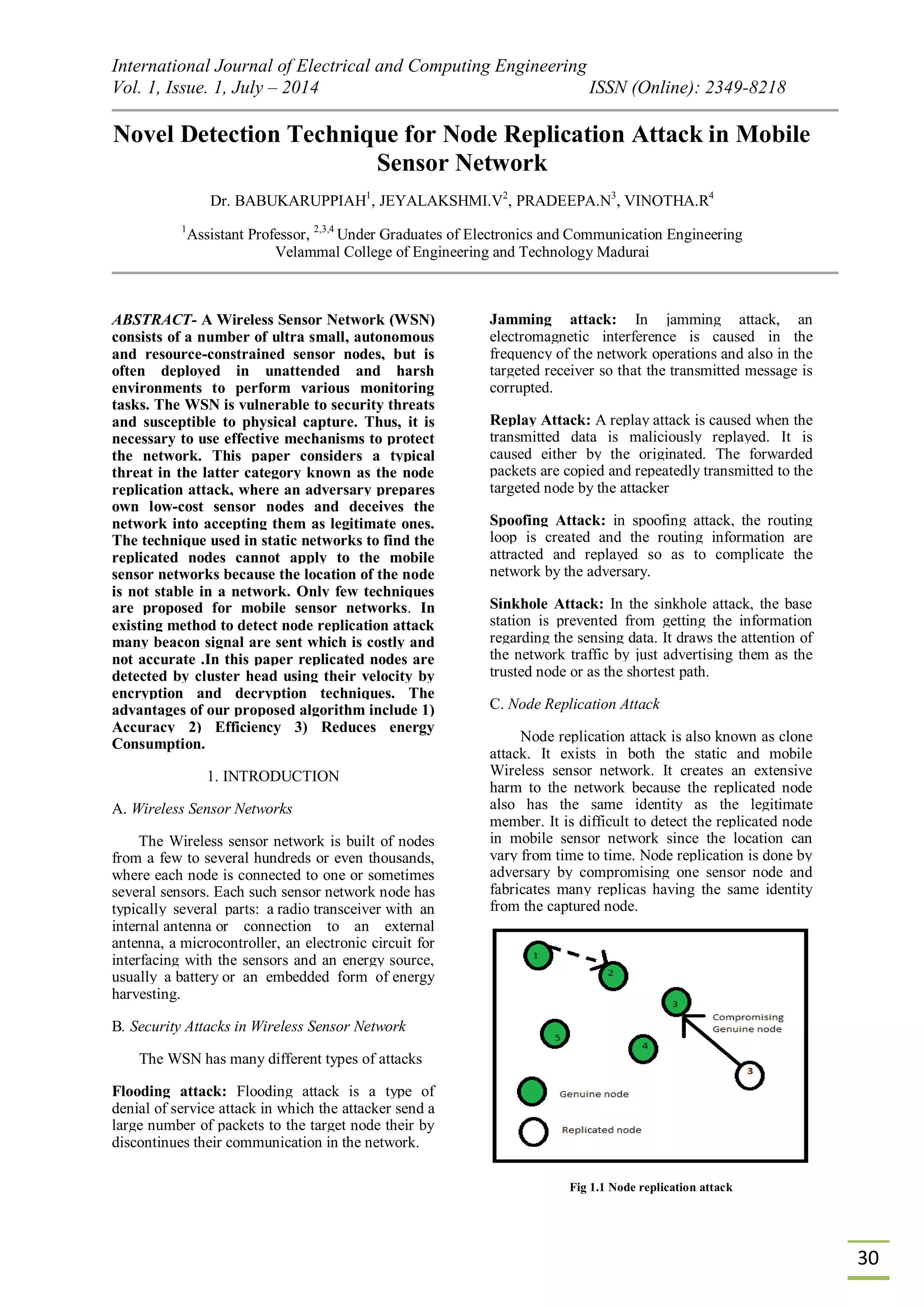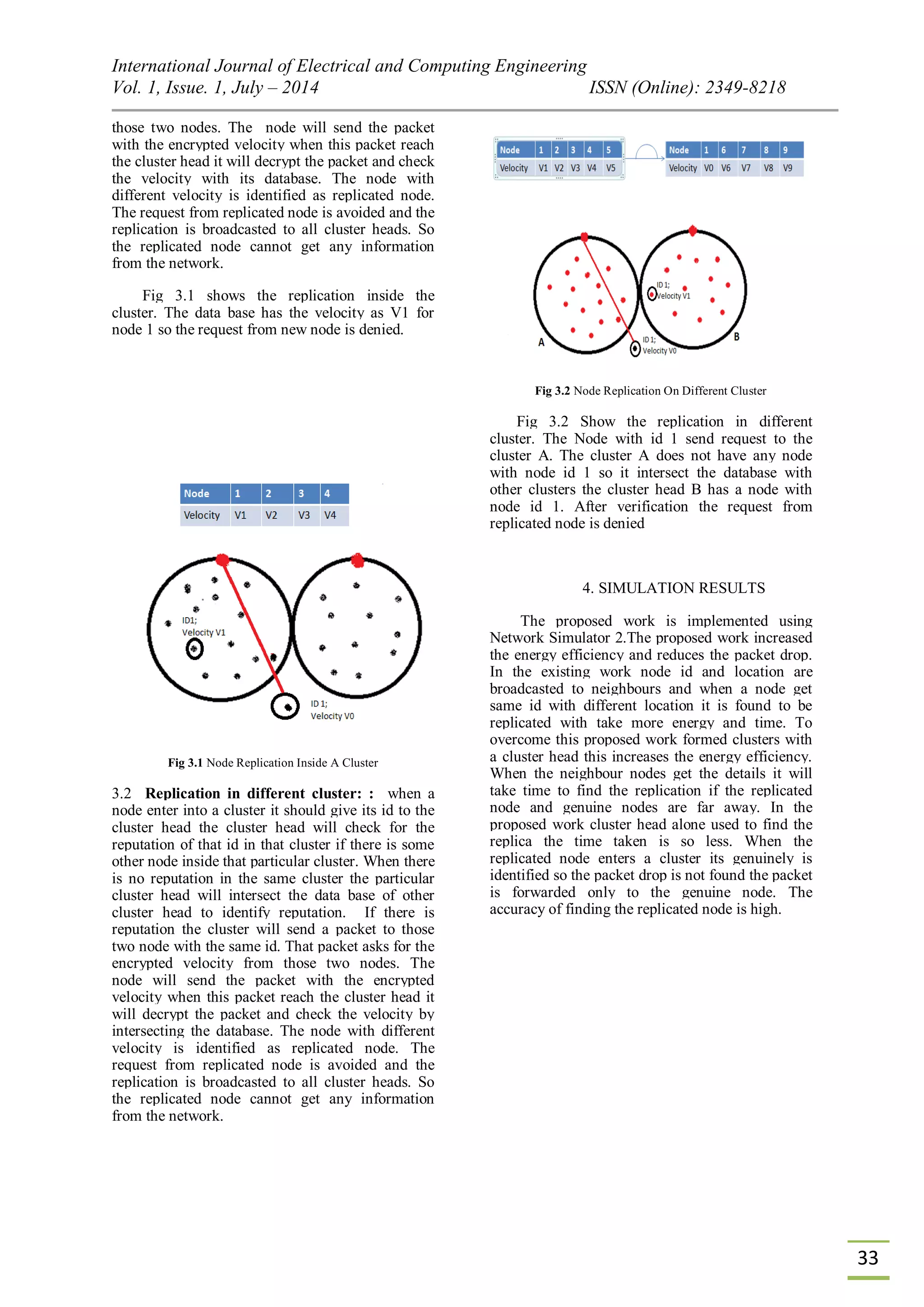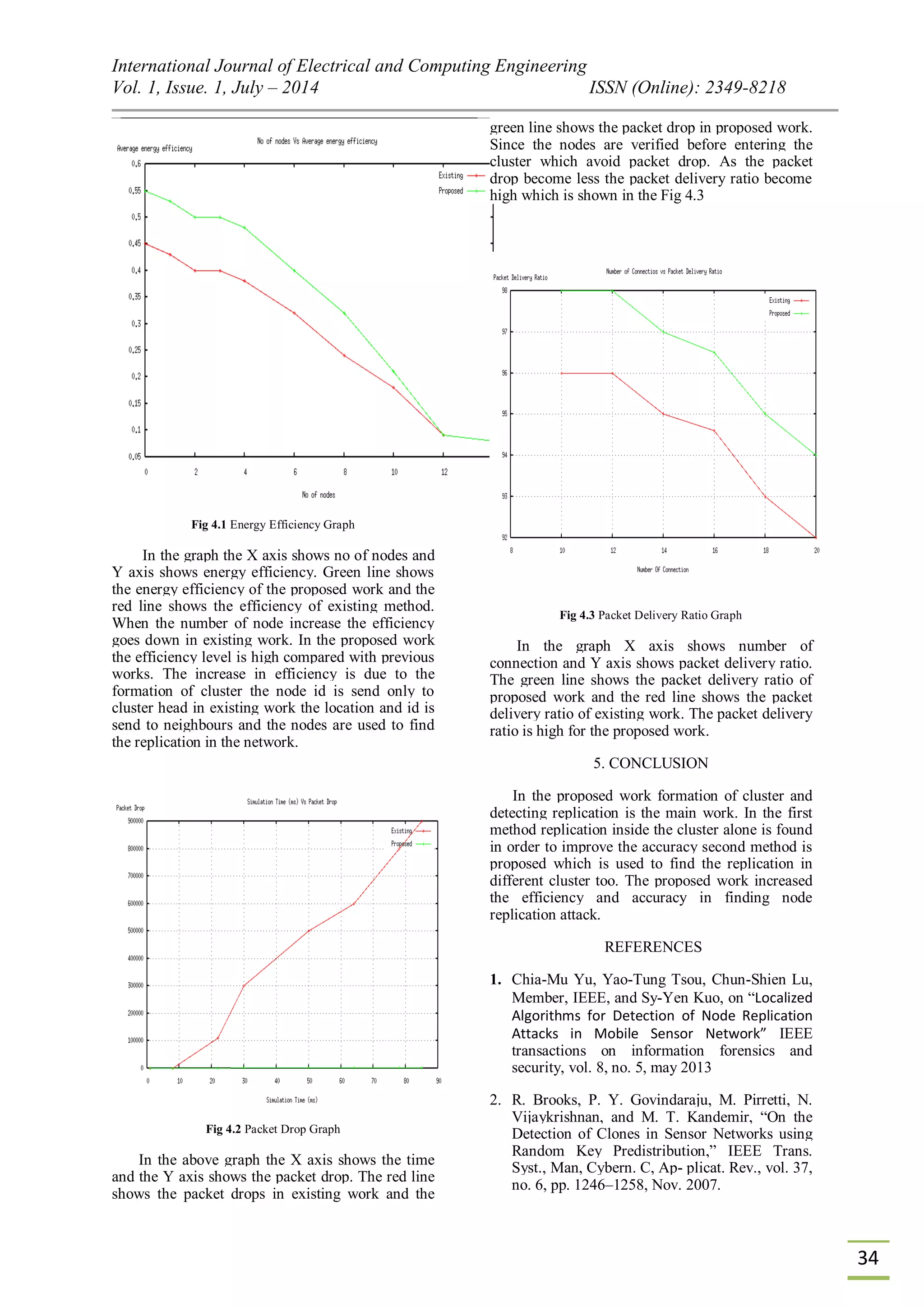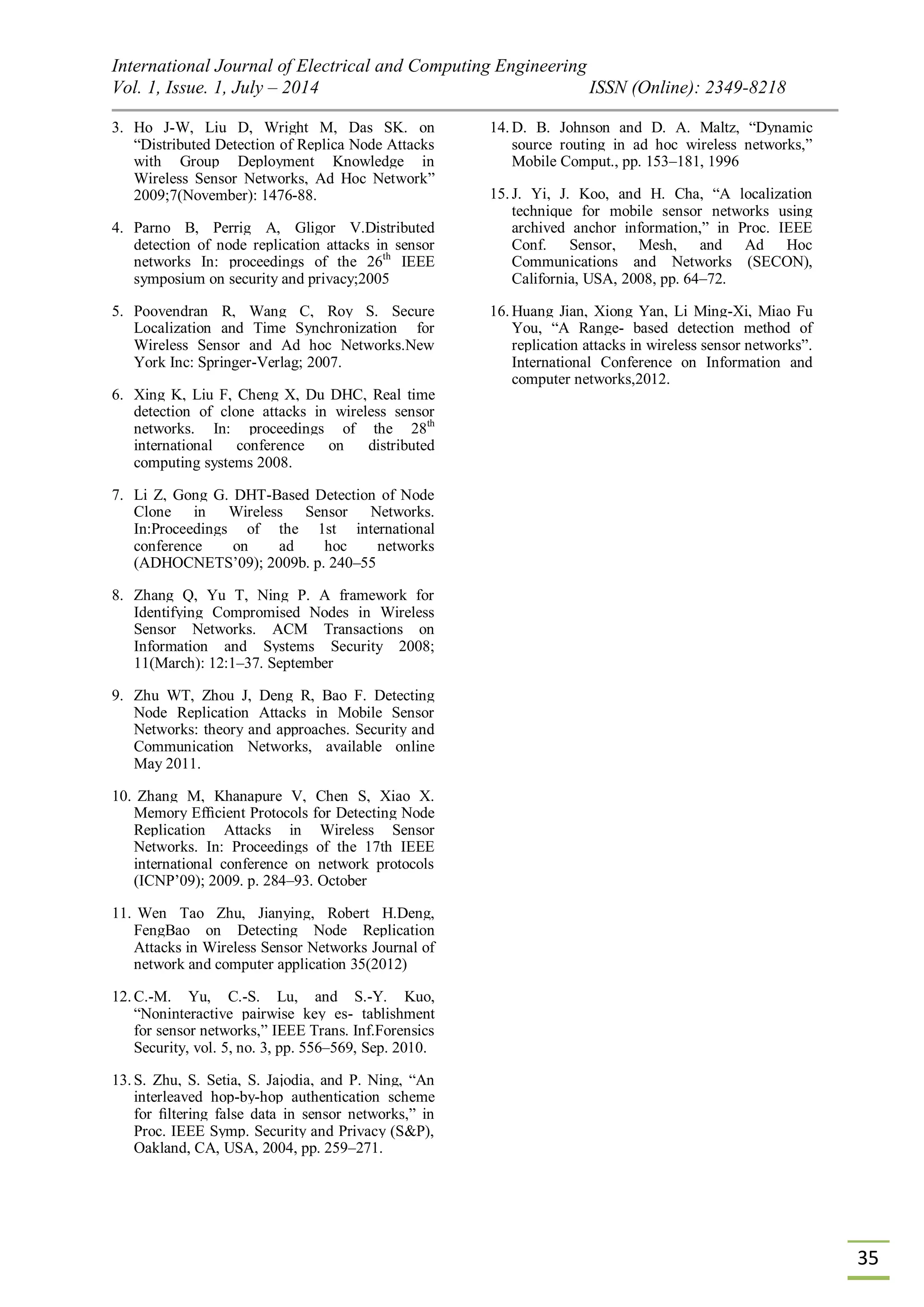This document discusses techniques for detecting node replication attacks in mobile sensor networks. It describes how node replication attacks work by allowing adversaries to create low-cost replica nodes with the same identity as legitimate nodes. Existing centralized detection methods for static networks, like using witness nodes or sending location data to a base station, do not work well for mobile networks where node locations change. The document proposes a new distributed detection method using cluster heads and encryption/decryption to detect replicated nodes based on their velocities. It argues this new method has advantages in accuracy, efficiency and reducing energy consumption compared to previous approaches.

![International Journal of Electrical and Computing Engineering Vol. 1, Issue. 1, July – 2014 ISSN (Online): 2349-8218 31 Fig 1.1 show the node replication attack where the attacker collecting information from genuine node to create a low cost replicated node It is desirable but very challenging to have efficient and effective distributed algorithms for detecting replicas in mobile sensor network. D. Related Works In mobile sensor networks many works are existing for node replication attack. In those papers they had discussed about the 1) Witness finding strategy 2) Setting threshold value 3) Detecting the nodes with same identity [1], which consume more energy, time and accuracy is less it cannot find the replicated node but it will identify the replicated and genuine node. So the data for both the node will be blocked. They send both the location and the signature ({L (v), sig (L (v))} where L (v) is the location of v, sig (L (v)) is the signature of v) to their neighbouring nodes which consume more energy and time to detect the replicated node. Sometimes the replication is not found in large networks. Clusters are formed only for stationary network [11] which will be more efficient for mobile sensor network. They found the replication only in a particular range [16] which cannot be used in mobile sensor network. A threshold value is set for all nodes to communicate with each other but some time the genuine node may have the necessary to communicate above the threshold so the accuracy is less [2].The witness-finding strategy exploits the fact that one sensor node cannot appear at different locations, but, unfortunately, the sensor nodes in mobile sensor networks have the possibility of appearing at different locations at different times, so the schemes in static wireless sensor networks cannot be directly applied to mobile sensor networks. Slight modification of these schemes can be helpful for applicability to mobile sensor networks. For instance, the witness- finding strategy can adapt to mobile environments if a timestamp is associated with each location claim. In addition, setting a fixed time window in advance and performing the witness-finding strategy for every units of time can also keep witness-finding feasible in mobile sensor networks. Nevertheless, accurate time synchronization among all the nodes in the network is necessary. Moreover, when witness-finding is applied to mobile sensor networks, routing the message to the witnesses incurs even higher communication cost. After identifying the replicas, a message used to revoke the replicas, possibly issued by the base station or the witness that detects the replicas, is usually flooded throughout the network. Nevertheless, network-wide broadcast is highly energy consuming and, therefore, should be avoided in the protocol design. Time synchronization is needed. Nevertheless, it is still a challenging task to synchronize the time of nodes in the network, even though loose time synchronization is sufficient for the detection purpose. Hence, as we know that time synchronization algorithms currently need to be performed periodically to synchronize the time of each node in the network, thereby incurring tremendous overhead, it would be desirable to remove this requirement. Witness-finding could be categorized as a strategy of cooper active detection; sensor nodes collaborate in certain ways to determine which ones are the replicas. In this regard, the effectiveness of witness-finding could be reduced when a large number of sensor nodes have been compromised, because the compromised nodes can block the message issued by the nodes near the replicas. Hence, the witness nodes cannot discover the existence of replicas. The effectiveness in detecting replicas, all of the schemes adopting witness-finding have the common drawback that the detection period cannot be determined. In other words, the replica detection algorithm can be triggered to identify the replicas only after the network anomaly has been noticed by the network planner. Therefore, a detection algorithm that can always automatically detect the replica is desirable. Since the existing algorithms are built upon several other requirements, we have found that the common weakness of the existing protocols in detecting node replication attacks is that a large amount of communication cost is still unavoidable [1]. The node replication attack in mobile sensor nodes are detected by two methods 1. Centralized Detection In mobile sensor networks there is only one centralized detection method called Sequential Probability Ratio Test (SPRT). 1.1 Sequential Probability Ratio Test: In SPRT [3], each and every time the node claims its location and time information to their neighbours and they forward it to the base station when they enter into a new location. 1.2 Straight Forward Scheme: In straight forward scheme [4] each node has to send a list of its neighbours and the positions claimed by these neighbours to the base station, which then examines every neighbour list to look for replicated sensor nodes. In a stationary WSN, conflicting position claims for one node id indicates a replication. Once the base station spots one or more DETECTION METHODS CENTRALIZED DETECTION DISTRIBUTED DETECTION](https://image.slidesharecdn.com/iisrt-6-nodedetectiontechniquefornodereplicationattackinmobilesensornetwork-150201063139-conversion-gate01/75/Iisrt-6-node-detection-technique-for-node-replication-attack-in-mobile-sensor-network-2-2048.jpg)
![International Journal of Electrical and Computing Engineering Vol. 1, Issue. 1, July – 2014 ISSN (Online): 2349-8218 32 replicas, it can revoke the replicated nodes by flooding the network with an authenticated revocation message. 1.3 Fingerprint Verification: This scheme consists of two phases [6]. In the first phase, each node u computes for each neighbour v ϵ N (u) the fingerprint FPv, which is a reflection of v‟s fixed neighbourhood characteristics; node v itself is also capable of computing FPv. In the second phase, the legitimacy of the originator for each message is verified by checking the enclosed fingerprint, and the detection is conducted both „„at the sensor side‟‟ (seemingly in a distributed manner by the notion) and at the base station. However, even the detection „„at the sensor side‟‟ needs the base station to process the alarms for decision making, and thus the scheme is throughout centralized. 1.4 Detecting Cloned Keys: It assumptions and application scenarios are quit different from other approaches in fact it addresses the detection of cloned cryptographic keys rather than cloned sensor nodes and falls into the category of anomaly detection [2]. The basic idea is that in the context of random key pre-distribution the keys employed by genuine nodes should follow a certain pattern. Therefore it is possible to monitor the key usage as authentication tokens and then detect statistical deviations that indicate clone attack. the approach detects the cloned keys by node authentication statistics those keys whose usage exceeds a certain threshold are considered cloned and erased from the network. 1.5 Set operation: SET logically partitions[11] the network into non overlapping regions respectively managed by leaders, and has these leaders respectively report to the base station all the ids of the nodes in the region, in the form of the subset. Intuitively, the “Intersection” of any two subsets of reports should be empty; otherwise, replication is detected 2. Distributed Detection There are two distributed detection methods they are eXtremely Efficient Detection (XED) and Efficient and Distributed Detection (EDD) [1] 2.1 Extremely Efficient Detection: XED has two steps Offline and Online step 2.1.1 Offline Step: It has a security parameter b and a cryptographic hash function h(.) are stored in each node. Two arrays of length n which keep the received random number and the materials used to check the legitimacy of received random number. Two arrays are initialized to zero vectors. B (u) - Initialized to be empty. 2.1.2 Online step: When two nodes u & v meet for first time it exchanges a random number. When v attempts to communicate with u next time, v should send the random number given by u during first meet. Then u check the random number given by v if the verification fails v will be blacklisted by u. If verification is success communication will be extended between u & v. The effectiveness of XED, unfortunately, heavily relies on the assumption that the replicas do not collude with each other. When replicas can communicate with each other, the replica can always share the newest received random numbers with the other neighbouring replicas, thus degrading the detection capability because multiple replicas are able to reply with the correct random number to encountered genuine nodes accordingly. 2.2 Efficient and Distributed Detection: EDD has two steps offline and online steps 2.2.1 Offline step: In the network without replicas, the number of times a node meets a specific node should be limited for a given time interval. 2.2.2 Online step: In the network with replicas, the number of times a node meets a particular node should be greater than the threshold. Since the effectiveness of EDD relies on the fact that each node faithfully and periodically broadcasts its ID, a strategy called selective silence could be taken by the replicas to compromise the detection capability of EDD. 3. PROPOSED WORK Assumed that sensor network consist of n node with node ID {1, 2, 3..., n}.The nodes are assumed to move with a constant velocity for a particular distance and then remain stationary for specified time. More over the nodes are assumed to communicate only during stationary period. The nodes are allowed to move randomly. The network is divided into clusters which are monitored by the respective cluster head. The cluster head maintain the data base which contain node ID, velocity and key for each node. The initial velocity of each node is encrypted with a key and stored as a packet in that particular node. Whenever a node enters into a cluster it should send its node id to the cluster head. This paper consists of two scenarios. 1. Replication inside a cluster 2. Replication in different cluster 3.1 Replication inside a cluster: when a node enter into a cluster it should give its id to the cluster head the cluster head will check for the reputation of that id in that cluster if there is some other node inside that particular cluster then the cluster will send a packet to those two node with the same id. That packet asks for the encrypted velocity from](https://image.slidesharecdn.com/iisrt-6-nodedetectiontechniquefornodereplicationattackinmobilesensornetwork-150201063139-conversion-gate01/75/Iisrt-6-node-detection-technique-for-node-replication-attack-in-mobile-sensor-network-3-2048.jpg)


